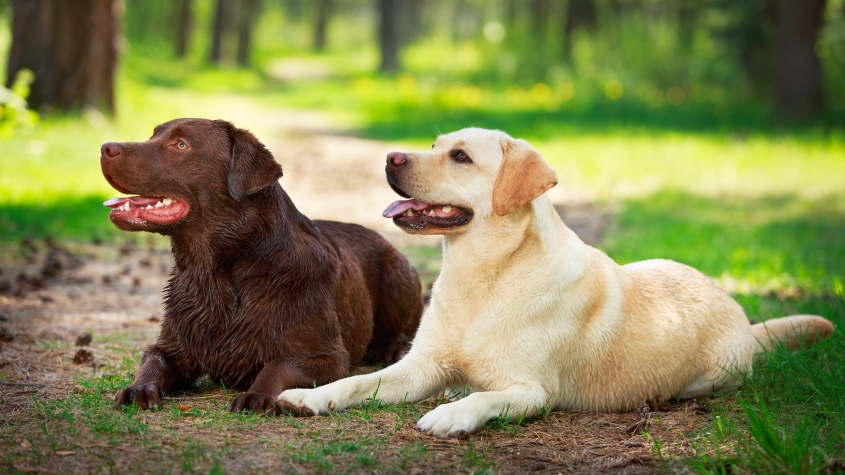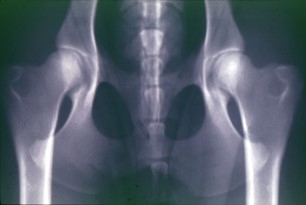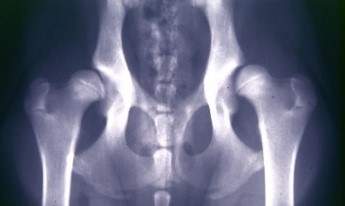Canine hip dysplasia (CHD)
Overview
Canine hip dysplasia (CHD) is a common inherited orthopedic condition that occurs when the hip joint forms incorrectly, leading to looseness or laxity. Over time, this laxity causes arthritis to develop, leading to pain and discomfort. CHD is common in medium and large breeds like Labradors, German Shepherds, Rottweilers and Bulldogs. Early diagnosis and interventions often result in the best patient outcomes. Some dogs may need minimal treatment, while others may need long-term medical management or surgical intervention. Dogs with CHD should never be used for breeding.
Cause
CHD is a genetic condition that can be modified by environmental influences, such as nutrition and growth rate. Overfeeding and rapid growth in puppies can worsen the condition in dogs already predisposed to CHD while restricted growth can reduce expression of the trait. Laxity in the hip joint caused by CHD eventually leads to loss of cartilage and bony remodeling and the development of osteoarthritis (OA).
Clinical signs
Dogs with CHD may show little to no signs early on, while others may show signs as early as a few months old or not until later in life, depending on the severity and development of arthritis.
- Difficulty getting up
- "Bunny-hopping" when running
- Limping or stiffness in the back legs
- Reduced activity or unwillingness to jump
- Decreased muscle mass in the hindlimbs
- Swaying in hips when walking
- Shifting weight to the forelimbs
Diagnosis
CHD is diagnosed by X-rays (radiographs) in combination with a physical exam and palpation of the hip joint (Ortolani sign). Specific positioning is needed for these radiographs, which requires dogs to be sedated or anesthetized for the imaging.
Two common methods for evaluating hips radiographically:
- PennHIP distraction method: The most accurate measurement of the amount of hip laxity in puppies. Veterinarians and technicians must be certified by the organization and use a special device to perform this technique.
- OFA (Orthopedic Foundation for Animals): Hips are graded based on radiographs taken after the dog is two years old. If the dog is younger than two years old, the OFA will assign a provisional certification. However, the OFA radiograph does not accurately predict the subsequent development of osteoarthritis in puppies, which misses a potential treatment window in affected dogs. Subtle changes in hip conformation can be difficult to detect, so a physical exam is always necessary to accompany the imaging.
A third method for detecting hip dysplasia is the Cornell dorsolateral subluxation method, which images a dog’s hips while it kneels on the table. This method correlates well with hip palpation, i.e., the Ortolani sign, and hence, hip laxity or instability.
Excellent hips in a Labrador Retriever | Dysplastic hips in a Labrador Retriever |
Treatment
Treatment for CHD depends on the severity of the condition, the dog's age and response to therapies. Many cases of CHD can be medically managed and is similar to the general management of OA of any major joint:
- Maintaining a healthy body weight (dogs should have a waist looking from the side and over the top)
- Nonsteroidal anti-inflammatory drugs (NSAIDs), which require intermittent monitoring of blood work and other pain relievers.
- Cartilage protective supplements and omega-3 fatty acids.
- Regenerative medicine therapy.
- Regular, low-impact exercise such as walking and swimming
- Physical therapy, including muscle strengthening exercises, acupuncture, etc.
Those with severe CHD who show a poor or inadequate response to medical management may be referred to a board-certified veterinary surgeon to discuss surgical options. These are generally considered salvage procedures.
- Femoral head and neck ostectomy (FHO): More common for small to medium-sized dogs.
- Total Hip Replacement (THR): More costly than an FHO but more common for large breed dogs.
If diagnosed early in puppies, before the onset of OA, some joint-preserving procedures may be recommended. These procedures must be performed within a specific window of time to have a chance of success.
- Juvenile Pubic Symphysiodesis (JPS): A minimally invasive surgery that must be performed between 12-20 weeks of age at the latest – the earlier, the better.
- Triple Pelvic Osteotomy (TPO): Involves placing implants in the pelvic bones and is preferably performed before orthopedic maturity, which for a Labrador Retriever-sized dog is eight months of age.
Outcome
Dogs with CHD can lead good quality lives with proper care, depending on the severity. Some dogs with CHD may require minimal support, while others may require a multi-modal approach to treatment. Maintaining a healthy weight and working closely with your veterinarian to develop an appropriate treatment plan can significantly improve their quality of life.
Dogs that undergo a THR can have normal gait and range of motion. Dogs that undergo FHO often experience reduced or limited range of motion but generally have good function and outcomes, particularly for dogs under 40 lbs.
JPS and TPO often have good success if performed at the appropriate age in eliminating joint laxity as the puppy grows.
Prevention
Responsible breeding practices can help reduce CHD in future generations. Avoid breeding dogs with a family history of CHD. Dogs should only be bred selectively after radiographically screening for CHD. A radiograph does not indicate genetic risk. A dog with normal hips can produce CHD offspring, depending on its mate. Genetic risk can only be evaluated by pedigree or the hip quality of the offspring of the same mating pairs (progeny testing).
Predisposed breeds or symptomatic puppies should be screened for hip laxity before 20 weeks of age via PennHIP and early interventions for joint preserving procedures such as JPS to prevent the development of severe CHD.
Avoid overfeeding, especially in fast-growing puppies of large breeds, and aim to maintain a healthy weight throughout life. Use properly formulated diets designed specifically for large breeds, especially when they are growing, and avoid supplementing growing puppies with calcium and vitamin D.
Updated Nov. 2024



